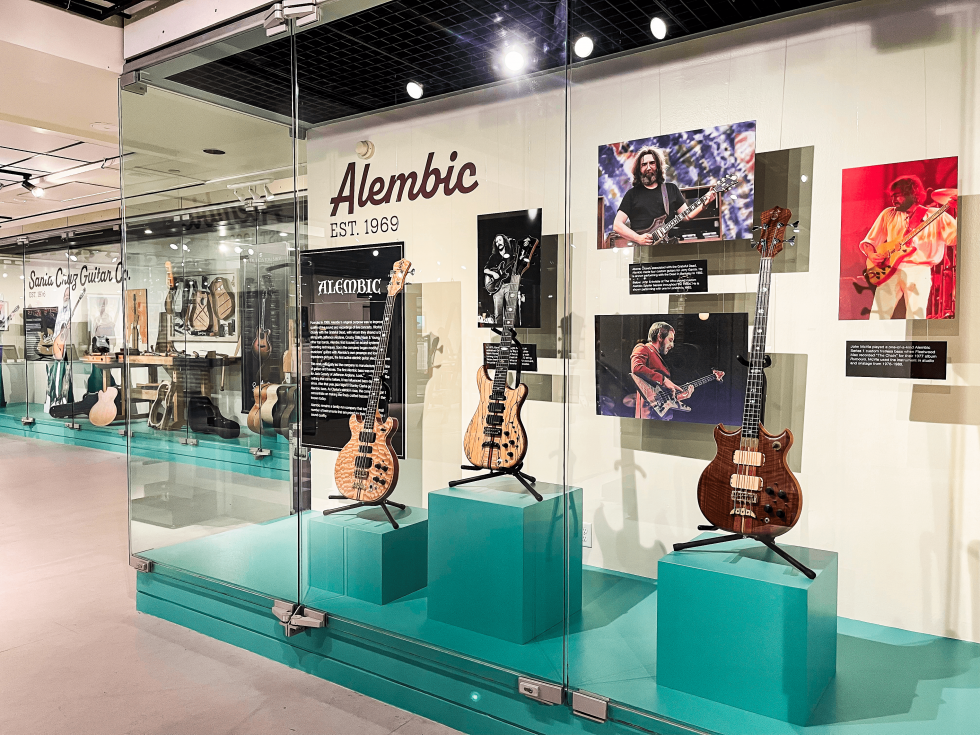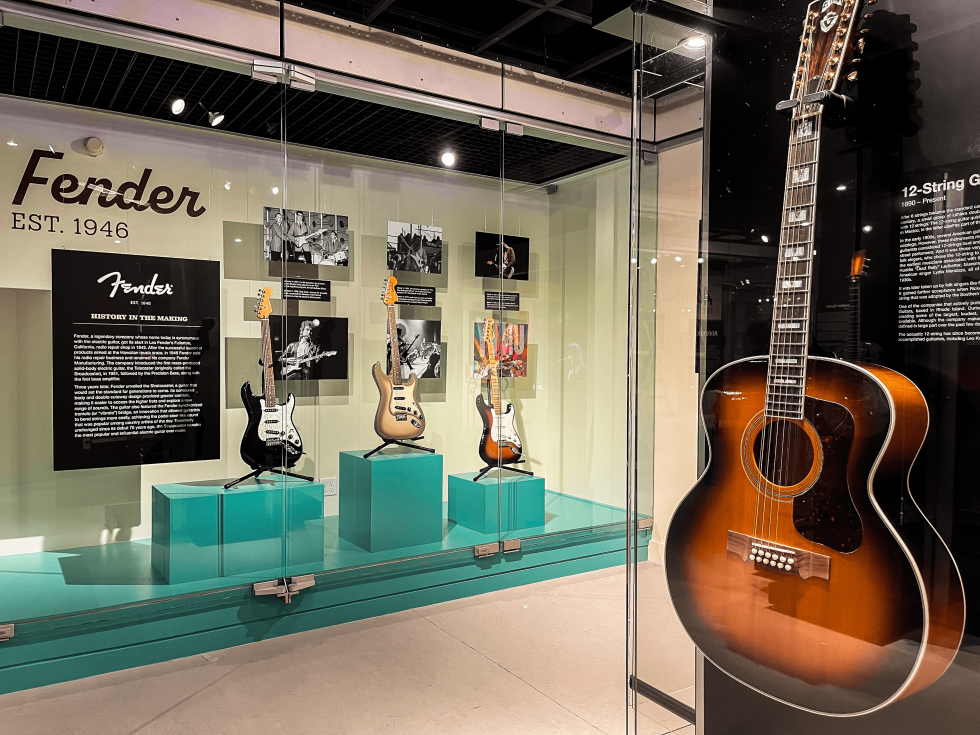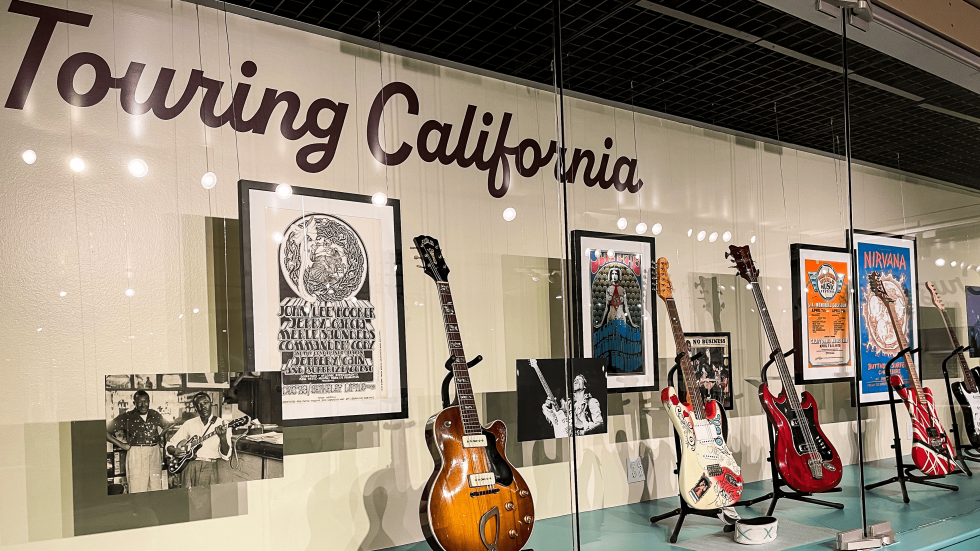Calling all guitar and music buffs: A Sacramento museum is going all rock ‘n’ roll, at least for the summer.
The National Guitar Museum’s traveling exhibit, “America at the Crossroads: Guitars and a Changing Nation,” is on view at the California Museum through September 1. Linking the evolution of the guitar to American history, the exhibit features 40 instruments, 10 video displays and more. The museum, at 10th and O Streets, has acquired an additional 18 guitars to highlight California guitar makers, including Fender, Taylor, Alembic and Santa Cruz Guitar Company.
“There are so many great, innovative guitar companies in California, so we really wanted to focus on them,” says Amanda Sanchez, director of exhibits at the California Museum. The Santa Cruz section serves as a gateway to the craft of guitar making, with workbenches, tools and guitar parts.
Music exhibits are rare in the museum world, but that’s part of its appeal: Sanchez said the California Museum has done an exhibit of rock concert posters before, but never anything like this.

The California Museum has acquired a guitar from California manufacturer Alembic to add to its traveling exhibits.
“Many of our exhibits focus on heavy themes like civil rights,” Sanchez says, “and I thought this would be a fun summer exhibit and might attract a different type of audience to the museum.”
Guitars are popular across generations and attract people who normally wouldn’t go to a museum, said HP Newquist, executive director of the National Guitar Museum, which has no permanent exhibits but hosts traveling exhibits. “People are drawn to the idea of guitars and pop culture and music,” he said. “Everybody knows someone who plays guitar, everybody plays guitar, everybody has a family member who plays guitar.”
Newquist says the goal of “America at Crossroads” is not just to provide eye candy (though there is plenty of that), but to trace American history through a familiar icon: the guitar.
“The idea is that by using the guitar as a symbolic icon, you can trace a significant portion, if not all, of American history through major events and major cultural cycles,” he says. “The guitar has been here since the beginning of the New World.”
A visit to the exhibit feels like walking through a timeline of guitars and historical events related to them, from the vihuela, a lute-like instrument brought by early Spanish settlers, to the wide variety of guitars made and played today. It’s all here: guitars used in blues, jazz, country, early rock, hard rock, surf rock, and punk rock, as well as film clips of famous musicians playing them. There are stunningly beautiful guitars (the Gretsch White Falcon, nicknamed the Cadillac of guitars, comes to mind), space-age guitars (including a Gibson Flying V), and crazy hybrids like a harp guitar (also a Gibson).
There’s even an air guitar — an empty case with just a caption describing the imaginary guitar-playing sport that was all the rage in the ’70s and ’80s. “It’s got to have humor,” says Newquist, who adds that it’s been popular at other host museums, too.
There’s a lot of attention being paid to one of pop culture’s most recognizable electric guitars, the Fender Stratocaster (“Strat”), famously played by everyone from Buddy Holly to Jimi Hendrix. If you’ve ever seen the footage of Hendrix setting his guitar on fire at the 1967 Monterey Pop Festival, you’ll recognize the replica of that guitar in the “Touring California” case – a white Strat with a multi-colored, psychedelic design.
Sanchez said the case is one of the most popular in the exhibit because it contains guitars from big-name musicians like Eddie Van Halen, John Lee Hooker and Kurt Cobain. “I loved Nirvana, so I thought, ‘There must be a way I can get Kurt Cobain’s guitar in this case,'” Sanchez said. He paired Cobain’s black-and-white Stratocaster with a poster from Nirvana’s concert at the Oakland Coliseum, part of the band’s 1993 “In Utero” tour.
Elsewhere in the exhibit is a shiny black Gibson ES-355 (“Lucille”) autographed by B.B. King, a guitar donated to the National Guitar Museum after presenting the blues giant with its Lifetime Achievement Award.
But of all the guitars in the room, it was a bright green Ibanez JEM that stopped Scott Gregory in his tracks.
“Wow,” Gregory said, eyes lighting up, as he approached the display case, “that’s the one I wanted.” A lifelong guitarist who’d played and performed in local bands for over 40 years, Gregory had seen just about everything six-string guitars were available. But the JEM really captured his heart, and the reason was simple: it was designed by Steve Vai, a guitar legend he’d always loved.
Gregory is a guitar nut himself, and works part-time at Skip’s Music as a guitar technician and repairman. His perspective on the exhibits is more detailed than most people’s — he probably wrote most of the museum’s signage himself, that’s how knowledgeable he is.
In fact, Gregory could only point to one guitar in the bunch he’d never seen before: a Visionary Instruments TeleVision, shaped like a Fender Telecaster with a full-color video screen built into the body. “That’s an unusual guitar,” Gregory said, gazing quizzically at the unusual instrument.

There’s been a lot of attention focused on pop culture’s most recognizable electric guitar, the Fender Stratocaster (the “Strat”).
That was the only real surprise he encountered, but Gregory felt the exhibit was worth seeing. “As a guitar lover, it was worth going,” he says. “There were certainly some very interesting pieces and exhibits.”
We both appreciated the small but significant “Women” exhibit, which featured video loops of famous female guitarists, including Bonnie Raitt, Nancy Wilson (of Heart) and Chrissie Hynde. “At Skip, we’re seeing a growing demographic of women playing guitar across all age groups,” says Gregory. “We even have women in their 70s who come for lessons every week.”
We agreed that the only thing that was a bit disappointing was that most of the videos, including this one, had the sound turned off (we even tried turning the knob). As Gregory says, “Music is an audio format.”
Sanchez said the museum decided to only provide sound for a few videos at a time (three by my count) due to space limitations. “I think it works better in a more open gallery space,” Sanchez said. “In this space, having all the videos on at once creates sensory overload.”
Sanchez said the best thing about the exhibit is that you don’t have to be a “guitar player” to enjoy it.
“I can’t play guitar at all,” she says with a bit of a laugh, “but I think most visitors will appreciate the creativity and craftsmanship of the guitars, and I think people of all ages will love them. Even little kids know what an electric guitar or a Stratocaster looks like from music videos and TV.”
In addition to being amazed by the cool guitars, Newquist said he hopes visitors to the exhibit will learn something new.
“We want people to at least walk away saying, ‘I didn’t know that, but now I do,'” he says.
The “America at the Crossroads: Guitars and a Changing Nation” exhibit runs through Sept. 1 at the California Museum, 1010 O Street in Sacramento. For more information, visit CaliforniaMuseum.org. For more information about the National Guitar Museum, visit nationalguitarmuseum.com.
–
Subscribe to Comstock’s newsletter today.


